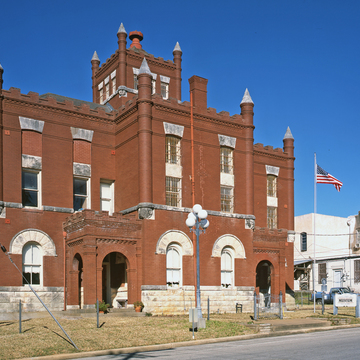You are here
Austin County Museum (Austin County Jail)
A catalogue-order building from the Pauly Jail Building Company of St. Louis, the jail is a dramatic example of Romanesque Revival architecture in this small town. Three stories in height, the building follows a cruciform plan with a fourth-floor tower projecting from the axial intersection. The rusticated limestone base supports dark red brick walls accented with contrasting limestone, culminating in crenellations and turrets. All the materials (brick and cut stone), along with windows, jail bars, and equipment, were ordered as a kit and shipped on the railroad for assembly by local contractors. The sheriff's family lived on the first floor; jail cells occupied the second and third levels. The hanging tower was used for only one execution before the jail closed in 1980 and was turned into a museum. The building was rehabilitated by Bailey Architects in 2004.
Writing Credits
If SAH Archipedia has been useful to you, please consider supporting it.
SAH Archipedia tells the story of the United States through its buildings, landscapes, and cities. This freely available resource empowers the public with authoritative knowledge that deepens their understanding and appreciation of the built environment. But the Society of Architectural Historians, which created SAH Archipedia with University of Virginia Press, needs your support to maintain the high-caliber research, writing, photography, cartography, editing, design, and programming that make SAH Archipedia a trusted online resource available to all who value the history of place, heritage tourism, and learning.


